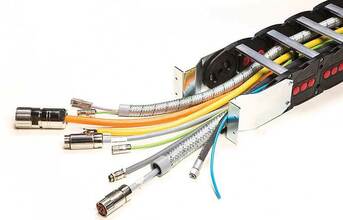
Flexible braiding
The screening braid plays an important role in a cable's flexibility. It blocks out interference from other cables, e.g. from motors or live cables. It is important that most of the screening braid is covered; no gaps should appear, even when the cable is bent. The braiding angle is the decisive factor here: the shallower it is, the more turns can be made in the wires in the braided shield per metre of cable, the thicker the braiding. Unfortunately, this also makes the cable more expensive
as more material is needed.
The ETHERLINE® FD Cat. 6A Ethernet cable, which is used for robot monitoring or inspecting finished products using camera systems, is an example of excellent shielding. Suitable for use in power chains, the ETHERLINE® TORSION Cat. 6A can even be used in applications where the cable is twisted. Until now, cables in accordance with Cat. 6A with data transmission rates of up to 10 Gbit/s were only possible
in fixed or slightly flexible installations.
Glass fibres can also bend
Fibre optic cables are the only option if you want even higher data rates. Users can choose between three fibre types: plastic optical fibres (POF) for shorter distances of up to 70 metres, plastic cladded fibres (PCF) for distances of up to 100 metres and glass fibres for even larger distances and applications requiring the highest data rates. In principle, all fibre types are suitable for flexible applications as long as the recommended bending radii are observed. However, in order to achieve the highest possible transmission performance, the bending radius in fibre optic cables should be at least 15 times greater than the diameter. While a lower bending radius will not cause it to break, it will lead to increased attenuation, meaning that light is lost in the tight curve and the signal quality will drop.
(Contiuned on next page)



































